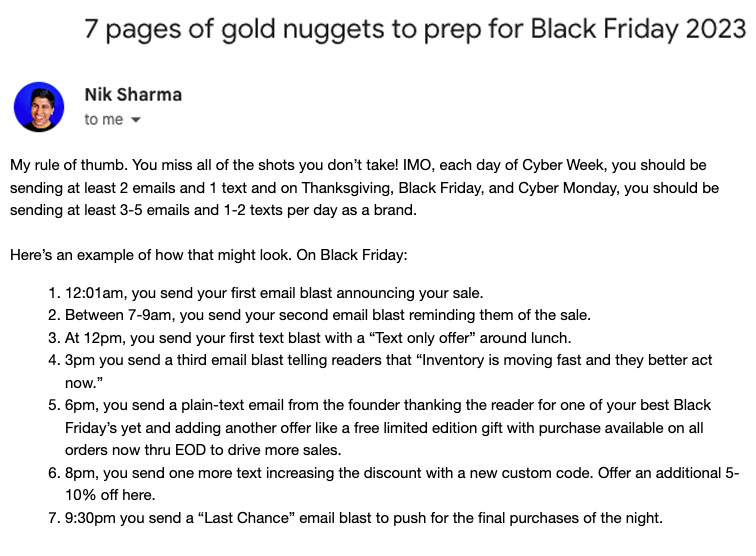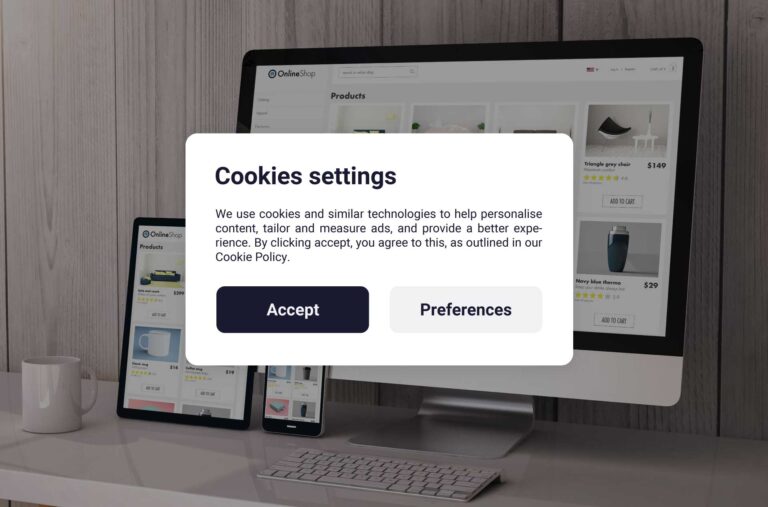The race is on, and Black Friday will be here before we know it. Marketers are working aggressively each year to create a new version of what they did last year. And since the holiday tends to sneak up on us (did we mention that there are only 100 days to go), they fail to realize that last year:
There was… lots of room for improvement.
However, some brands got it right. If you didn’t, keep in mind that a mistake made on Black Friday or Cyber Monday may not only impact your revenue for that week, but may drastically reduce returning customer rates and future revenue for your business, ultimately jeopardizing your growth objectives.
So, as I was researching for this blog post, I came across Nik Sharma’s recent newsletter, where he found and shared a bunch of stats about BFCM 2022. Here were his key findings:
“Olympics of ecommerce”
First, I loved how Mr. Sharma frames Q4 as the “Olympics of ecommerce”. Brilliant.
He continues…
“The world’s best brands take center stage to compete with each other on the best offers, the best ads, the best landing pages and more. And the prize is real. Last year, according to Salesforce, consumers spent $65.3 billion on Black Friday and $46.2 billion on Cyber Monday globally. That’s a lot of cash. In the US, consumers spent $9.12 billion on Black Friday and $11.3 billion on Cyber Monday. Shopify merchants, you know, the entrepreneurs that keep the country alive, accounted for $7.5B of those sales with more than 52 million consumers purchasing from brands, all powered by Shopify, which was a 12% increase from 2021 (big when you think about all the talk of a slowing economy).”
Additionally:
- Last year witnessed a remarkable 78% surge in buy now, pay later usage during Black Friday week compared to the preceding week. The prevalence of BNPL is evident, and overlooking its integration as an option for your store translates to a significant missed opportunity for boosting sales.
- Notably, an unprecedented 48% of all e-commerce sales and 78% of web traffic on Black Friday originated from mobile devices in the previous year. This underscores the importance of consistent testing and optimization of ad campaigns, landing pages, and emails for mobile users. Given that the majority of initial clicks and 48% of total sales emanate from mobile platforms, prioritizing mobile optimization is paramount.
- The average order values stood at $105 globally, and for U.S. sales, the figure was $120. This price range serves as the sweet spot to target as a brand. It’s prudent to strategize around a hero offer or a bundle that can effectively compete for wallet share within the $99-$120 range.
Also, he shares some stats from Shopify:
Shopify merchants displayed remarkable performance last year during BFCM, and given Shopify’s continued growth as a platform, one can anticipate an upward trajectory in their Black Friday/Cyber Monday sales as well.
Here are some notable statistics specific to Shopify that captured Mr. Sharma’s attention: Total BFCM sales for Shopify merchants witnessed a substantial 19% year-over-year increase.
The standout product categories were as follows:
- Apparel & Accessories (Consider athleisure, bags, luggage, phone cases, hats, etc.)
- Health & Beauty (Think supplements, powders, skincare items, serums, creams, vitamins, and more.)
- Home & Garden (Imagine bedding, furniture, cookware, gardening tools, and supplies, among others.)
So, it is expected that this Black Friday and Cyber Monday will be one of the most competitive shopping seasons of all time, given that consumer confidence and budgets are increasing.
How can you differentiate? The answer: Make every dollar count.
But first, Nik Sharma’s Key Recommendations:
Start Early: Sharma, also stressed the importance of initiating campaigns ahead of time in his weekly newsletter. Looking back at 2022, it’s evident that brands commenced their strategies earlier than ever. Nik Sharma and his colleague, Moiz, even have a friendly wager regarding the likelihood of witnessing “Black Friday/Cyber Monday” emails from brands as early as November 1st this year. These preemptive emails might entice customers with messages like “Skip the line. Get our BFCM offer early!” or “Avoid the stress and shop our Black Friday offers today.” These brands are certainly forward-thinking. The rationale behind this strategy is crystal clear—by enabling consumers to make an informed choice in favor of your brand amidst the deluge of advertisements and offers during Cyber Week, you secure a larger portion of the coveted wallet share.
Treat Cyber Week Like a Fundraising Round: He recommends that more brands should treat Cyber Week like a fundraising round. Instead of raising capital from investors, you are raising capital from customers (which is always the best thing to do!). Additionally, Mr. Sharma emphasizes that the exact same care and attention that goes into a Series A fundraise should go into nailing your cyber week campaigns. Making the most of this week can help your brand strengthen its balance sheet for what’s typically a softer Q1 in the ecommerce world.
SMS and Email for the win: As we’re all aware, email and SMS channels continue to contribute significantly to total DTC sales. This underscores the importance of proactive communication throughout Cyber Week, meaning frequent emails and texts – even multiple times daily. Don’t think your competitors are taking every opportunity they can get to reach their customers’ inboxes? According to Klaviyo, brands sent over 10 billion messages via their platform during last year’s BFCM alone.
Also, since 48% of all e-commerce sales and 78% of web traffic on Black Friday originated from mobile devices in 2022, innovative companies like Onetext are making it easier for consumers to buy from their phones through a simple sms response. Their CEO, Jonathan Funden, believes that In the future, brands having a list of customers with cards on file will be as ubiquitous as email and sms subscriber lists.
If you are looking for tactical advice, Mr. Sharma recommends

Make every dollar count
Attracting consumers to your store, PDPs, and landing pages is just the first step. Once they land on your territory, you must deliver a unique shopping experience to make sure they don’t bounce, and your store is capitalizing on that dollar spent to bring shoppers in.
But how? Well, is artificial intelligence on your Black Friday and Cyber Monday checklist?
We’re all hearing about it. AI is the next big thing. We get it. How to embrace it effectively? We will demonstrate to you how artificial intelligence and machine learning technologies present opportunities to elevate engagement and increase conversion rates rather than some buzzword. An article published by MarTech said that the majority of marketers, accounting for 88%, recognize the imperative for their organizations to enhance the utilization of automation and AI in order to effectively address customer expectations and maintain a competitive edge.
Tools like ChatGPT may help write content for marketers, and chatbots may interact with your existing customers throughout the website, but predicting what your customers want in real-time and effectively displaying individual content and product recommendations throughout your store, search results, PDPs, landing pages, and marketing channels without lifting a finger is only possible by leveraging a predictive AI platform that can orchestrate all that movement for your automatically.
Let’s dive into 5 Ways to Upgrade Your Store for Black Friday using Predictive AI
Here is a checklist of five essential items to ensure your team is on top of, with just 100 days until the year’s biggest shopping day.
Make site search as good as Google search
If you could hire a Google machine learning engineering team that built Google search, what would be the impact on your online store’s throughput?
Predictive search by Aidaptive does just that.
Sometimes search should be personalized by the individual. (Often.) But AI may determine that the best search experience looks different based on other hidden factors.
Introduce predictive search on your site in advance of Black Friday to prepare your website for a fully optimized experience. Gather learnings from search queries and performance, and let the AI sharpen its skills for a few months before the big holiday week.
Implement AI-Powered Recommendations
In today’s fast-paced world, customers crave convenience.
If you aren’t serving the right recommendations immediately, you only have seconds until they bounce and find another promotion.
That’s where it’s crucial to leverage the power of AI. Recommendations for stores with over 100 SKUs should be dynamically selected by a self-learning algorithm.
AI can help you tap into the full potential of intelligent product recommendation algorithms. These algorithms analyze user behavior, purchase history, and preferences to provide conversion-optimized product recommendations at every point along the customer shopping journey.
This enhances the customer experience and opens doors for cross-selling and upselling opportunities.
Prep your website merchandising to be dynamic
With Black Friday just 100 days away, you need to take immediate action to ready your site with intelligent merchandising. This will dynamically shift your product ordering, images, and placement.
So what? This intelligent re-ordering and prioritizing is a data-driven way to let AI convert more users. Period.
We all know that slow-loading pages can result in higher bounce rates, but offering a highly-relevant visual merchandising experience decreases bounce rates significantly and drives more add-to-carts.
Use predictive merchandising to let AI show the images and product ordering on each page that statistically will drive the most revenue.
The earlier you start, the more time the AI has to learn what makes your customers tick.
Launch AI-driven audience segmenting and content for marketing emails / SMS
Your email campaigns in Klaviyo, Hubspot, or otherwise should be partially or fully automated – tied to how users behave on your website. If that’s not already set up – stop reading and prioritize building those email workflows.
But once you have a functioning email program, AI lets you start identifying segments that will convert more frequently with certain campaigns and product types.
Further, each email that goes out can be tailored to that user’s predicted preferences and intent with content and recommendations with higher click rates and greater purchase rates.
Black Friday / Cyber Monday emails are par for the course. You’ll probably send between 20-100! But enhancing their capabilities with AI starting early gives you an edge to increase performance by 10-20% per email. It’s a no-brainer.
Machine-learning is your superpower
In an age where digital commerce is flooded with choices, retailers and DTC brands are faced with a crucial question: how can they ensure that customers are presented with the products they are most likely to purchase? The answer lies with AI and Machine Learning. Enter the new era of predictive eCommerce AI platforms.
Imagine a digital storefront that operates seamlessly, round the clock, showcasing not just any products but the right ones. By “right,” we mean those with the highest propensity to resonate with the shopper and lead to a successful transaction. This isn’t a mere wishful feature; it’s an evolution driven by sophisticated, underlying technology.
At the heart of this revolutionary platform are algorithms and models working tirelessly 24/7, analyzing and interpreting data from myriad sources. Be it a newcomer to the store or a returning customer, the platform dives deep into user profiles, past behavior, and current market trends. It then matches this wealth of information to the individual’s preferences, ensuring that the displayed products and experiences align with their tastes and buying patterns.
Such a system isn’t just about automation; it’s about personalization and conversion rate optimization at scale. It promises an e-commerce experience where every product recommendation feels curated, every suggestion seems intuitive, and every purchase feels predestined. It makes every interaction count and maximizes your revenue potential. And this year’s BF/CM numbers will prove it.
If you don’t know where to start, Aidaptive is offering a 90-day trial of AI-powered conversion rate optimization and site search. It’s the perfect opportunity to fine-tune your website and unleash the full potential of your AI engine for the holiday season.
Get your trial started today and let’s get you ready. Only 100 days to go.


